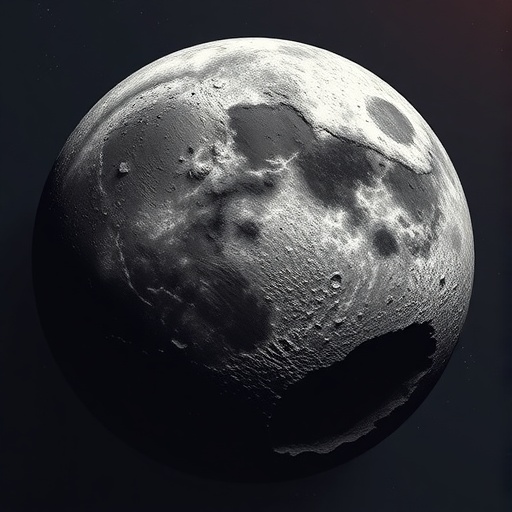Recent advancements in lunar geology have produced groundbreaking discoveries, unveiling the existence of high-pressure minerals and submicroscopic metallic iron within a shocked lunar meteorite. This newfound knowledge reveals not only the complex geological history of the Moon but also provides insight into the violent processes that shape planetary bodies. The significance of these findings stretches beyond lunar research, prompting a reevaluation of the dynamic processes that govern the evolution of other celestial objects, including Earth.
The research, led by a team of scientists, including notable experts like Gu, L., Wang, N., and Lin, Y., focuses on a specific lunar meteorite that has been subjected to extreme shock conditions. Through a series of meticulous analyses, researchers were able to identify a range of high-pressure minerals that are typically formed under deep planetary conditions. This discovery opens a new chapter in our understanding of the Moon’s geological past and the broader implications for planetary science.
High-pressure minerals act as indicators of the extreme conditions that the meteorite experienced. Many of these minerals, such as stishovite and reidite, are known to form under intense pressure and temperature, conditions that are frequently found during impact events. The presence of these minerals suggests that the meteorite arose from a region of the Moon that experienced significant impacts, likely a remnant from a time when the lunar surface was much more dynamic and chaotic than it is today.
The implications of finding submicroscopic metallic iron within this lunar meteorite are equally profound. Submicroscopic particles, often measuring less than one micrometer in size, provide unique insights into the chemical processes that occur during high-energy events like impacts. These metallic grains may hold clues about the essential processes that contribute to planetary differentiation and the formation of iron-rich cores within terrestrial bodies.
Additionally, understanding the mineralogical makeup of the meteorite allows scientists to compare it against other lunar samples collected during various missions, such as the Apollo program. These comparisons can reveal not only the diversity of materials found on the Moon but also the varying histories those materials may embody. As researchers unveil these hidden stories, they contribute to a narrative that paints a more nuanced picture of the Moon’s geological evolution.
The discovery of these minerals also raises intriguing questions about the formation of Earth’s own geology. The Moon is considered a key player in the history of the Earth-Moon system, and studying its materials can provide insights into the conditions that existed over 4 billion years ago. By examining the similarities and differences between lunar and terrestrial samples, geologists may begin to unravel the processes that have shaped both bodies over eons of geological time.
In addition to providing a window into the past, the findings from this research could hold practical implications for future lunar exploration. As space agencies and private companies plan missions to the Moon, insights gleaned from such studies could inform strategies for resource utilization. The identification of high-pressure minerals and metallic iron could lead to novel approaches for extracting materials that may be vital for sustaining human presence on the lunar surface.
Moreover, understanding the nature of these minerals could play a significant role in future planetary defense strategies. By recognizing the potential impact of such minerals on the structure and composition of celestial bodies throughout the solar system, planetary scientists may develop more effective methods for predicting and mitigating the consequences of cosmic impacts.
As the research community continues to probe deeper into the nature of the solar system, studies like this one underscore the rich tapestry of interactions that shape the evolution of planetary bodies. The shocking revelation of high-pressure minerals and submicroscopic metallic iron in a lunar meteorite not only enchants the imagination but inspires a generation of scientists and laypeople alike to look to the stars and understand our place within the cosmos.
While the specifics of this lunar meteorite provide insights into the Moon’s history, the broader implications of this study extend into a myriad of scientific fields. Understanding how impacts affect planetary bodies informs everything from the geological modeling of other celestial objects to potential exoplanetary research. The principles discovered in this research can thus create a ripple effect, influencing a multitude of scientific inquiries.
With the ongoing interest in lunar exploration, this research will likely garner further attention in the coming years. As more samples are retrieved from the lunar surface and analyzed, the potential for discovering similar or even more complex geological features increases. Each embarkation into lunar territory is an opportunity to enhance our understanding of not just our nearest neighbor in space, but of the broader dynamics that govern planetary formation across the universe.
In conclusion, the identification of high-pressure minerals and submicroscopic metallic iron in this lunar meteorite signifies a substantial leap in lunar geology, shedding light on processes that are crucial for understanding planetary formation and evolution. As researchers continue to explore and analyze such fascinating materials, they will undoubtedly uncover more exciting truths about the Moon and its relationship to our Earth, igniting the scientifically curious minds around the world. A future filled with lunar discoveries awaits us, promising to further enrich our exploration of space and our understanding of the history of celestial bodies.
Subject of Research: Lunar geology, high-pressure minerals, and metallic iron in lunar meteorite.
Article Title: Abundant high-pressure minerals and submicroscopic metallic iron discovered in a shocked lunar meteorite.
Article References:
Gu, L., Wang, N., Lin, Y. et al. Abundant high-pressure minerals and submicroscopic metallic iron discovered in a shocked lunar meteorite. Commun Earth Environ 6, 915 (2025). https://doi.org/10.1038/s43247-025-02876-z
Image Credits: AI Generated
DOI: https://doi.org/10.1038/s43247-025-02876-z
Keywords: Lunar meteorite, high-pressure minerals, submicroscopic metallic iron, geological processes, lunar exploration.




